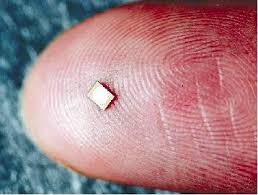
In earlier articles I have predicted the rise of Smart Implants in Orthopedic medicine. Now it’s 2013 and there is no stopping it…embedded sensors are coming to Orthopedics. This is driven by a convergence of three areas – new technology capabilities in embedded sensing, a growing understanding of embedded chip capabilities by Orthopedic manufacturers, and incentives for manufactures (product differentiation) and healthcare providers (more cost effective care).
Now let’s get specific. What will be the first applications of Smart Implants in Orthopedics? And when will these new applications emerge? I see four generations of embedded chip technology coming to Orthopedics.
“Smart tools intra-operatively” 1st Generation in 2009
The first chips will be used in Orthopedic surgery this year. Instruments with chips and RFID tags will help surgeons make better decisions during surgery. Smart instruments and trials with embedded sensors will help surgeons with the implant positioning and load balancing during surgery. I consider smart tools simply another level of surgical navigation, but these new tools with chips and RFID tags have several advantages over optical systems. This technology is cheap, portable, disposable and most important of all, may give manufacturers a way to earn another fee for each joint
replacement surgery. Major orthopedic companies are working on these applications now.
“Smart diagnostics on demand” 2nd Generation in 2012
In 2012, chips will help provide better care during regular patient visits. The first smart implants with embedded sensors will relay diagnostic data from inside the patient to a physician or health care worker in the hospital setting post-surgery. These smart implants delivery much more information than x-rays. They may provide data in the doctor’s office, such as implant positioning, load bearing data, range-of-motion (ROM) data, dislocation potential, bone ingrowth measurement, particle count around an implant (a link to osteolysis), temperature, pH, lactate, glucose levels and other local biochemistry. These chips will become the “black box” in every implant. Other applications may be the use of smart diagnosis chips for use in human clinical trials and animal trials to derive more meaningful data with fewer subjects. The only application that exists today is a 2005 JNJ DePuy custom knee patient with a total knee with an embedded transducer that relays load information from the tibial implant.
“Smart diagnostics by exception” 3rd Generation in 2015
Around 2015, tiny diagnostic chips in total joint devices will sit silently for years until a problem is detected. The patient could be anywhere when the chip comes alive and sends diagnostic data through existing wireless infrastructure to the hospital of record. These smart implants will only send wireless data when they detect problems, such as, an early infection (based on bio markers present), osteolysis (the silent killer in joints), and stress shielding leading which often leads to bone erosion, loosening and revision surgery. This will add enormous value to the health care system.
“Smart diagnostics and treatment by exception” 4th Generation in 2021
In the early 20’s smart implants will be able to analyze and treat. This breed of smart implants will detect a problem and “self treat” the problem by delivering drug therapies locally as needed. They may delivery antibiotics and growth factors long after surgery. Once again these smart on-board drug delivery vehicles will be completely dormant until they are needed.
Thoughts?

 Tiger Buford – retained recruiter dissecting orthopedics
Tiger Buford – retained recruiter dissecting orthopedics 